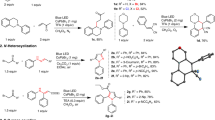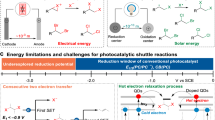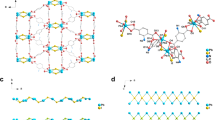Abstract
Organolead halide perovskites, primarily regarded as a high-performance semiconducting component in photovoltaics, have excellent optical and charge-transport characteristics that are advantageous for photocatalysis. However, their moisture-sensitive nature largely hinders their application to water splitting. Here we report a semiconductive organolead iodide layered crystalline material ([Pb8I8(H2O)3]8+[–O2C(CH2)4CO2–]4) with a bandgap of ~2.74 eV that demonstrates a high robustness over a wide pH range as well as under aqueous boiling conditions. The Earth-abundant material maintains excellent optical characteristics similar to those of perovskites, and includes suitable band positions, excellent carrier diffusion lengths (up to 1.4 μm) and long carrier lifetimes (up to 1.2 μs). When illuminated by sunlight and combined with trace amounts of a Rh co-catalyst, the hybrid iodoplumbate steadily and efficiently produces stoichiometric amounts of hydrogen and oxygen in a recyclable manner. Our findings extend the excellent optoelectronic properties of organolead halide materials from photovoltaics to photocatalytic water splitting.

This is a preview of subscription content, access via your institution
Access options
Access Nature and 54 other Nature Portfolio journals
Get Nature+, our best-value online-access subscription
$29.99 / 30 days
cancel any time
Subscribe to this journal
Receive 12 digital issues and online access to articles
$119.00 per year
only $9.92 per issue
Buy this article
- Purchase on Springer Link
- Instant access to full article PDF
Prices may be subject to local taxes which are calculated during checkout




Similar content being viewed by others
Data availability
The data that support the findings of this study are available from the corresponding author upon reasonable request. X-ray crystal structure data (CCDC no. 1983043) is available in Supplementary Data 1. The atomic coordinates of the DFT calculation data for TJU-16 and the 2D perovskite hydrolysis process are available in Supplementary Data 2 and 3, respectively.
References
Kudo, A. & Miseki, Y. Heterogeneous photocatalyst materials for water splitting. Chem. Soc. Rev. 38, 253–278 (2009).
Zou, Z., Ye, J., Sayama, K. & Arakawa, H. Direct splitting of water under visible light irradiation with an oxide semiconductor photocatalyst. Nature 414, 625–627 (2001).
Chen, S., Takata, T. & Domen, K. Particulate photocatalysts for overall water splitting. Nat. Rev. Mater. 2, 17050 (2017).
Hisatomi, T., Kubota, J. & Domen, K. Recent advances in semiconductors for photocatalytic and photoelectrochemical water splitting. Chem. Soc. Rev. 43, 7520–7535 (2014).
Liu, J. et al. Metal-free efficient photocatalyst for stable visible water splitting via a two-electron pathway. Science 347, 970–974 (2015).
Osterloh, F. E. Inorganic nanostructures for photoelectrochemical and photocatalytic water splitting. Chem. Soc. Rev. 42, 2294–2320 (2013).
Wang, L., Zhang, Y., Chen, L., Xu, H. & Xiong, Y. 2D polymers as emerging materials for photocatalytic overall water splitting. Adv. Mater. 30, 1801955 (2018).
Maeda, K. & Domen, K. Photocatalytic water splitting: recent progress and future challenges. J. Phys. Chem. Lett. 1, 2655–2661 (2010).
Chen, S. et al. Efficient visible-light-driven Z-scheme overall water splitting using a MgTa2O6–xNy/TaON heterostructure photocatalyst for H2 evolution. Angew. Chem. Int. Ed. 54, 8498–8501 (2015).
Wang, Z. et al. Overall water splitting by Ta3N5 nanorod single crystals grown on the edges of KTaO3 particles. Nat. Catal. 1, 756–763 (2018).
Zhang, G., Lan, Z. A., Lin, L., Lin, S. & Wang, X. Overall water splitting by Pt/g-C3N4 photocatalysts without using sacrificial agents. Chem. Sci. 7, 3062–3066 (2016).
Tanaka, A., Teramura, K., Hosokawa, S., Kominami, H. & Tanaka, T. Visible light-induced water splitting in an aqueous suspension of a plasmonic Au/TiO2 photocatalyst with metal co-catalysts. Chem. Sci. 8, 2574–2580 (2017).
Iwashina, K., Iwase, A., Ng, Y. H., Amal, R. & Kudo, A. Z-schematic water splitting into H2 and O2 using metal sulfide as a hydrogen-evolving photocatalyst and reduced graphene oxide as a solid-state electron mediator. J. Am. Chem. Soc. 137, 604–607 (2015).
Low, J., Dai, B., Tong, T., Jiang, C. & Yu, J. In situ irradiated X-ray photoelectron spectroscopy investigation on a direct Z-scheme TiO2/CdS composite film photocatalyst. Adv. Mater. 31, 1802981 (2019).
Wei, Y., Wang, J., Yu, R., Wan, J. & Wang, D. Constructing –SrTiO3-TiO2 heterogeneous hollow multi-shelled structures for enhanced solar water splitting. Angew. Chem. Int. Ed. 58, 1422–1426 (2019).
Mohamed, N. A. et al. Efficient photoelectrochemical performance of γ irradiated g-C3N4 and its g-C3N4@BiVO4 heterojunction for solar water splitting. J. Phys. Chem. C 123, 9013–9026 (2019).
Nasir, S. N. F. M. et al. New insights into Se/BiVO4 heterostructure for photoelectrochemical water splitting: a combined experimental and DFT study. J. Phys. Chem. C 121, 6218–6228 (2017).
Safaei, J. et al. Enhanced photoelectrochemical performance of Z-scheme g-C3N4/BiVO4 photocatalyst. Appl. Catal. B 234, 296–310 (2018).
Ullah, H. Inter-molecular interaction in polypyrrole/TiO2: a DFT study. J. Alloy. Compd. 692, 140–148 (2017).
Ullah, H., Tahir, A. A., Bibi, S., Mallick, T. K. & Karazhanov, S. Z. Electronic properties of β-TaON and its surfaces for solar water splitting. Appl. Catal. B 229, 24–31 (2018).
Ullah, H., Tahir, A. A. & Mallick, T. K. Polypyrrole/TiO2 composites for the application of photocatalysis. Sensors Actuators B 241, 1161–1169 (2017).
Ullah, H., Tahir, A. A. & Mallick, T. K. Structural and electronic properties of oxygen defective and Se-doped p-type BiVO4(001) thin film for the applications of photocatalysis. Appl. Catal. B 224, 895–903 (2018).
Low, J., Yu, J., Jaroniec, M., Wageh, S. & Al-Ghamdi, A. A. Heterojunction photocatalysts. Adv. Mater. 29, 1601694 (2017).
Xiao, J. D. & Jiang, H. L. Metal–organic frameworks for photocatalysis and photothermal catalysis. Acc. Chem. Res. 52, 356–366 (2019).
McMeekin, D. P. et al. A mixed-cation lead mixed-halide perovskite absorber for tandem solar cells. Science 351, 151–155 (2016).
Brenner, T. M., Egger, D. A., Kronik, L., Hodes, G. & Cahen, D. Hybrid organic–inorganic perovskites: low-cost semiconductors with intriguing charge-transport properties. Nat. Rev. Mater. 1, 15007 (2016).
Li, W. et al. Chemically diverse and multifunctional hybrid organic–inorganic perovskites. Nat. Rev. Mater. 2, 16099 (2017).
Shi, D. et al. Low trap-state density and long carrier diffusion in organolead trihalide perovskite single crystals. Science 347, 519–522 (2015).
Xing, G. et al. Long-range balanced electron- and hole-transport lengths in organic–inorganic CH3NH3PbI3. Science 342, 344–347 (2013).
Christians, J. A., Miranda Herrera, P. A. & Kamat, P. V. Transformation of the excited state and photovoltaic efficiency of CH3NH3PbI3 perovskite upon controlled exposure to humidified air. J. Am. Chem. Soc. 137, 1530–1538 (2015).
Park, S. et al. Photocatalytic hydrogen generation from hydriodic acid using methylammonium lead iodide in dynamic equilibrium with aqueous solution. Nat. Energy 2, 16185 (2017).
Mosconi, E., Azpiroz, J. M. & De Angelis, F. Ab initio molecular dynamics simulations of methylammonium lead iodide perovskite degradation by water. Chem. Mater. 27, 4885–4892 (2015).
Wu, Y. et al. Composite of CH3NH3PbI3 with reduced graphene oxide as a highly efficient and stable visible-light photocatalyst for hydrogen evolution in aqueous HI solution. Adv. Mater. 30, 1704342 (2018).
Wang, X. et al. Dynamic interaction between methylammonium lead iodide and TiO2 nanocrystals leads to enhanced photocatalytic H2 evolution from HI splitting. ACS Energy Lett. 3, 1159–1164 (2018).
Wang, H., Fang, C., Luo, H. & Li, D. Recent progress of the optoelectronic properties of 2D Ruddlesden–Popper perovskites. J. Semicond. 40, 041901 (2019).
Spanopoulos, I. et al. Uniaxial expansion of the 2D Ruddlesden–Popper perovskite family for improved environmental stability. J. Am. Chem. Soc. 141, 5518–5534 (2019).
Tsai, H. et al. High-efficiency two-dimensional Ruddlesden–Popper perovskite solar cells. Nature 536, 312–316 (2016).
Zhuang, Z. et al. Intrinsic broadband white-light emission from ultrastable, cationic lead halide layered materials. Angew. Chem. Int. Ed. 56, 14411–14416 (2017).
Yin, J., Yang, H. & Fei, H. Robust, cationic lead halide layered materials with efficient broadband white-light emission. Chem. Mater. 31, 3909–3916 (2019).
Cheetham, A. K., Rao, C. N. R. & Feller, R. K. Structural diversity and chemical trends in hybrid inorganic–organic framework materials. Chem. Commun. 46, 4780–4795 (2006).
Cao, S., Low, J., Yu, J. & Jaroniec, M. Polymeric photocatalysts based on graphitic carbon nitride. Adv. Mater. 27, 2150–2176 (2015).
Liu, G. et al. Unique electronic structure induced high photoreactivity of sulfur-doped graphitic C3N4. J. Am. Chem. Soc. 132, 11642–11648 (2010).
Zheng, Y., Lin, L., Wang, B. & Wang, X. Graphitic carbon nitride polymers toward sustainable photoredox catalysis. Angew. Chem. Int. Ed. 54, 12868–12884 (2015).
Chun, W. J. et al. Conduction and valence band positions of Ta2O5, TaON, and Ta3N5 by UPS and electrochemical methods. J. Phys. Chem. B 107, 1798–1803 (2003).
Kudo, A., Omori, K. & Kato, H. A novel aqueous process for preparation of crystal form-controlled and highly crystalline BiVO4 powder from layered vanadates at room temperature and its photocatalytic and photophysical properties. J. Am. Chem. Soc. 121, 11459–11467 (1999).
Hong, S. J., Lee, S., Jang, J. S. & Lee, J. S. Heterojunction BiVO4/WO3 electrodes for enhanced photoactivity of water oxidation. Energy Environ. Sci. 4, 1781–1787 (2011).
Walsh, A., Payne, D. J., Egdell, R. G. & Watson, G. W. Stereochemistry of post-transition metal oxides: revision of the classical lone pair model. Chem. Soc. Rev. 40, 4455–4463 (2011).
Wang, H., Wong, K. S., Foreman, B. A., Yang, Z. Y. & Wong, G. K. L. One- and two-photon-excited time-resolved photoluminescence investigations of bulk and surface recombination dynamics in ZnSe. J. Appl. Phys. 83, 4773–4776 (1998).
Kim, M., Cahill, J. F., Su, Y., Prather, K. A. & Cohen, S. M. Postsynthetic ligand exchange as a route to functionalization of ‘inert’ metal–organic frameworks. Chem. Sci. 3, 126–130 (2012).
Mu, L. et al. Enhancing charge separation on high symmetry SrTiO3 exposed with anisotropic facets for photocatalytic water splitting. Energy Environ. Sci. 9, 2463–2469 (2016).
Pan, C. et al. A complex perovskite-type oxynitride: the first photocatalyst for water splitting operable at up to 600 nm. Angew. Chem. Int. Ed. 54, 2955–2959 (2015).
Maeda, K. et al. Preparation of core–shell-structured nanoparticles (with a noble-metal or metal oxide core and a chromia shell) and their application in water splitting by means of visible light. Chem. Eur. J. 16, 7750–7759 (2010).
APEX-II 2.1.4 (Bruker-AXS, 2007).
SHELXTL, Crystal Structure Determination Package (Bruker-AXS, 1999).
Brandenburg, K. & Putz, H. Diamond (Crystal Impact, 2007).
Kresse, G. & Furthmuller, J. Efficiency of ab-initio total energy calculations for metals and semiconductors using a plane-wave basis set. Comput. Mater. Sci. 6, 15–50 (1996).
Kresse, G. & Hafner, J. Norm-conserving and ultrasoft pseudopotentials for first-row and transition-elements. J. Phys. Condes. Matter 6, 8245–8257 (1994).
Perdew, J. P. & Wang, Y. Accurate and simple analytic representation of the electron–gas correlation energy. Phys. Rev. B 45, 13244–13249 (1992).
Grimme, S., Antony, J., Ehrlich, S. & Krieg, H. A consistent and accurate ab initio parametrization of density functional dispersion correction (DFT-D) for the 94 elements H–Pu. J. Chem. Phys. 132, 154104 (2010).
Grimme, S., Ehrlich, S. & Goerigk, L. Effect of the damping function in dispersion corrected density functional theory. J. Comput. Chem. 32, 1456–1465 (2011).
Wang, H. F. & Liu, Z. P. Comprehensive mechanism and structure-sensitivity of ethanol oxidation on platinum: new transition-state searching method for resolving the complex reaction network. J. Am. Chem. Soc. 130, 10996–11004 (2008).
Shang, C. & Liu, Z. P. Constrained Broyden minimization combined with the dimer method for locating transition state of complex reactions. J. Chem. Theory Comput. 6, 1136–1144 (2010).
Zhang, X. J., Shang, C. & Liu, Z. P. Double-ended surface walking method for pathway building and transition state location of complex reactions. J. Chem. Theory Comput. 9, 5745–5753 (2013).
Acknowledgements
This work was supported by grants from the National Natural Science Foundation of China (21971197, 51772217 and 21603165), the Shanghai Rising-Star Program (no. 20QA1409500), the Recruitment of Global Youth Experts by China, the Fundamental Research Funds for the Central Universities and the Science & Technology Commission of Shanghai Municipality (14DZ2261100 and 19DZ2271500).
Author information
Authors and Affiliations
Contributions
X.S. and H.F. conceived the project design. X.S. synthesized TJU-16 and conducted the overall water-splitting reactions. X.S., C.P., J.Y., Y.J. and X.Z. carried out the characterization of TJU-16. G.W. and J.S. performed the theoretical calculations. H.F. supervised the research. X.S., G.W. and H.F. wrote and revised the paper. All the authors commented on the paper.
Corresponding author
Ethics declarations
Competing interests
The authors declare no competing interests.
Additional information
Peer review information Nature Catalysis thanks the anonymous reviewers for their contribution to the peer review of this work.
Publisher’s note Springer Nature remains neutral with regard to jurisdictional claims in published maps and institutional affiliations.
Supplementary information
Supplementary Information
Supplementary Figs. 1–26, Tables 1–6 and references.
Supplementary Data 1
Crystallographic Data of TJU-16.
Supplementary Data 2
Atomic coordinates of TJU-16 (IS, TS and FS) in DFT calculations.
Supplementary Data 3
Atomic coordinates of 2D perovskites (IS, TS and FS) in DFT calculations.
Rights and permissions
About this article
Cite this article
Song, X., Wei, G., Sun, J. et al. Overall photocatalytic water splitting by an organolead iodide crystalline material. Nat Catal 3, 1027–1033 (2020). https://doi.org/10.1038/s41929-020-00543-4
Received:
Accepted:
Published:
Issue Date:
DOI: https://doi.org/10.1038/s41929-020-00543-4
This article is cited by
-
Large electronegativity differences between adjacent atomic sites activate and stabilize ZnIn2S4 for efficient photocatalytic overall water splitting
Nature Communications (2024)
-
Electric double layer-mediated polarization field for optimizing photogenerated carrier dynamics and thermodynamics
Nature Communications (2023)
-
Internal quantum efficiency higher than 100% achieved by combining doping and quantum effects for photocatalytic overall water splitting
Nature Energy (2023)
-
In situ constructing atomic interface in ruthenium-based amorphous hybrid-structure towards solar hydrogen evolution
Nature Communications (2023)
-
Bromo- and iodo-bridged building units in metal-organic frameworks for enhanced carrier transport and CO2 photoreduction by water vapor
Nature Communications (2022)



